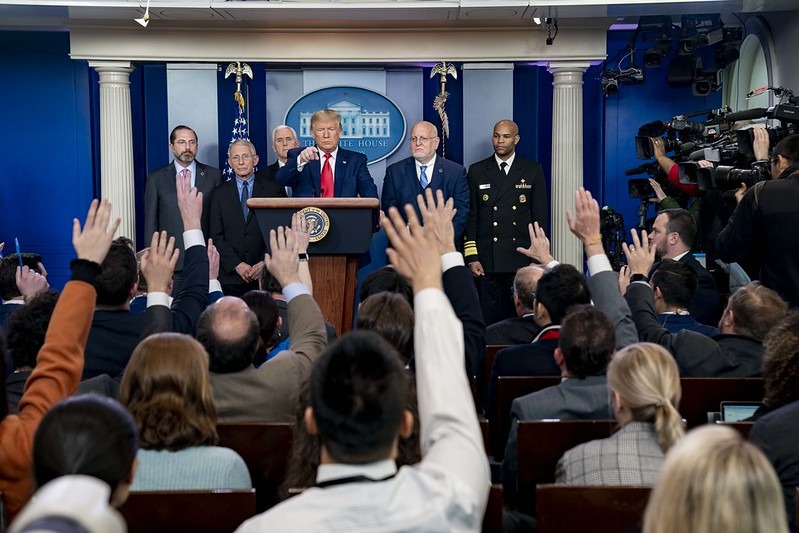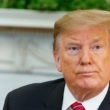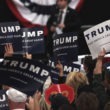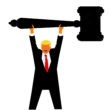It’s too soon to know whether Trump’s slow-motion and deadly response to the coronavirus outbreak will contribute to his political undoing. But even that enticing prospect offers little consolation, measured against the reality that this rudderless nation has been left flatfooted in the face of an advancing plague.
Trump spent months minimizing the known threat. While the president, as The New Yorker put it, “simultaneously underplayed the severity of the outbreak and overpromised the means available to fight it,” the numbers of confirmed cases piled up; his administration introduced faulty test kits, fatally impeding state and local efforts to inhibit the early spread of the virus; critical care facilities were overwhelmed, becoming transmission centers themselves; hospitals ran out of supplies; and people died in ever-increasing numbers. The markets took one look at the intensifying crisis and dove off the cliff.
Faced with these compounding realities, Trump reversed course and announced he had known the virus was a pandemic all along. “This is a pandemic,” Trump told reporters in mid-March. “I felt it was a pandemic long before it was called a pandemic.”
Trump could have mobilized a nation to collective action, but chose instead to hold “Keep America Great” rallies where he mocked the threat of the virus and called it a Democratic hoax. Trump could have established much-needed protocols and equipped the public with the tools to combat the virus, and survive, but instead he used the presidential pulpit to scapegoat China and blame Obama.
Trump’s winter of indifference will cost American lives, but it wasn’t the main precipitating factor in America’s vulnerability to the COVID-19 virus. The roots of this tragedy trace back to the early months of his presidency, long before anyone had heard of Wuhan, when the newly-elected president sharply reduced the budgets of the nation’s infectious disease prevention system, and in particular the emergency health preparedness infrastructure put in place by the Obama administration to fight the Ebola outbreak.
On his second full day in office, Trump introduced a 90-day hiring freeze, which left nearly 700 positions at the Centers for Disease Control unfilled. According to researchers and health officials interviewed by The Washington Post, the freeze adversely affected programs that supported local and state public health emergency readiness, infectious disease control and chronic disease prevention. Given the CDC’s crucial role in detecting and stopping infectious disease outbreaks, the public health community sounded the alarm.
A document obtained at the time by the Sierra Club through a Freedom of Information Act Request, and reviewed by The Post, revealed that several of the vacancies were senior positions in the Office of Public Health Preparedness and Response, which according to The Post regulated some of the world’s most dangerous bacteria and viruses and managed the nation’s stockpile of emergency medical countermeasures.
Liz Perera, the Sierra Club’s public health policy director, was quoted in May 2017 that the administration’s “thoughtless freeze on hiring public servants prevented the CDC from filling critical roles at programs essential to preventing chronic and infectious diseases, advancing immunization and safeguarding environmental health.”
In January of 2018 The Wall Street Journal reported that the CDC was scaling back its global health security agenda because of Trump-mandated budget cuts. In February of the same year The Washington Post confirmed the agency was reducing its programs aimed at fighting global health threats by 8o percent.
Microsoft founder Bill Gates, who has focused much of his philanthropy on global health issues, lobbied Trump repeatedly on the issue of global pandemics and inadequate US preparedness, from the moment the president first arrived at the White House. Gates earned headlines in the press in 2018 for his assessment that the U.S. government was falling short in preparing the nation and the world for the “significant probability of a large and lethal modern-day pandemic occurring in our lifetimes.” Gates reportedly told Trump he had the chance to lead on the issue of global health security, and pressed his case several times with the former National Security Advisor H. R. McMaster.
Yet the top White House official in charge of fighting pandemics left the Trump administration abruptly in May, 2018, and the global health security team he oversaw was subsequently disbanded under then National Security Advisor John Bolton. Conservatives have since argued this was meant as a consolidation to improve efficiency.
The New York Times reported in October, 2019 that the Trump administration had shut down PREDICT, a key resource in the global campaign against pandemics. Administered by USAID, the goal of PREDICT was to speed up and organize the hunt for zoonotic diseases—like Ebola and COVID-19—that may jump from animals to humans.
Senior officials at the internationally valued program explained that under Trump the USAID had taken on an “economic” focus, and that “risk-averse” bureaucrats could not be counted on to defend the science-based initiative.
Widespread public condemnation has greeted Trump’s maddening refusal to consider scientific counsel on a range of issues, from public health and environmental protections to the growing global movement on climate. With an administration that prioritized the concerns of industry over the role of science in government decisions, nearly 1600 federal scientists left the government in Trump’s first two years in office. And at the end of his third year, 39 out of 79 scientific leadership positions remained vacant.
In a 2018 survey compiled by the Union of Concerned Scientists, half of the respondents at the CDC agreed that “political interests hindered the ability of their [agency] to make science-based decisions.” One respondent at the CDC observed that “proposed funding cuts limits our [agency’s] capacity for responding to infectious disease overseas and domestically. These cuts don’t just affect our ability to prepare and respond at a federal level either. These will disproportionally affect smaller state and local health departments and grant funded programs.”
Trump has systematically sought to defund the agencies that protect national and global health, For three years running he proposed drastic budget cuts at the CDC, the leading national agency for the research, detection and prevention of infectious diseases like COVID-19. The Washington Post reported recently that his 2021 budget proposal, released 11 days after the WHO declared the coronavirus outbreak was an international public health emergency—featured a 16% reduction in the CDC’s total outlay.
Across his four proposed budgets, Trump has attempted to cut nearly $154 million from the programs of the National Center for Immunization and Respiratory Diseases, whose experts are responsible for the testing of infectious diseases such as COVID-19, and to assist in the development of immunization protocols and vaccines.
Given the nationwide shortages of COVID-19 tests, questions abound around why the Trump administration chose not to use a functioning test from the World Health Organization. The administration could have removed regulations that prevented private hospitals and labs from quickly developing their own tests, but didn’t. This inaction meant that the United States fell behind South Korea, Singapore and China in fighting the virus. “We just twiddled our thumbs as the coronavirus waltzed in,” William Hanage, a Harvard epidemiologist, wrote.
When asked last week about the government’s lack of preparedness for the COVID-19 outbreak, Trump responded, “Nobody knew there’d be a pandemic or an epidemic of this proportion. Nobody’s ever seen anything like this before.”
Not quite. Under the headline “Before Virus Outbreak, A Cascade of Warnings went Unheeded,” The New York Times reported on March 22 that Trump’s own Department of Health and Human Services conducted a simulation of a pandemic in 2019. “The simulation’s sobering results—contained in a draft report dated October 2019 and marked ‘not for disclosure’—drove home just how underfunded, underprepared and uncoordinated the federal government would be for a life-or-death battle with a virus for which no treatment existed.”
Twice before, according to The Times article, the federal government had issued dire warnings about official lack of preparedness and the country’s vulnerability to infectious pandemics. “In 2016, the Obama administration produced a comprehensive report on the lessons learned by the government from battling Ebola. In January 2017, outgoing Obama administration officials ran an extensive exercise on responding to a pandemic for incoming senior officials of the Trump administration.”
All three of these authoritative exercises identified the same challenges Trump is now belatedly scrambling to confront, armed with an underfunded and ill-prepared bureaucracy, hamstrung by years of his own indifference and mismanagement on the part of his administration.
On March 16 at a Rose Garden ceremony convened to declare a national emergency, when the Teflon curtain across his presidency had finally been drawn, revealing a nation on lock-down and an economy in shambles, Trump was asked about his role in the system-wide collapse. The 45th President of the United States resorted for once to the truth, and without irony: No, I don’t take responsibility at all.
Hamilton Fish is the editor of the Washington Spectator.







0 Comments